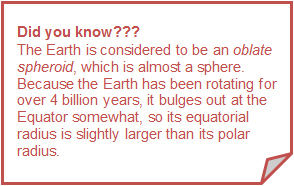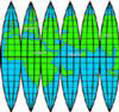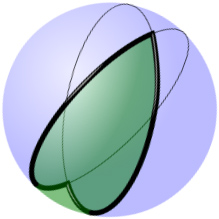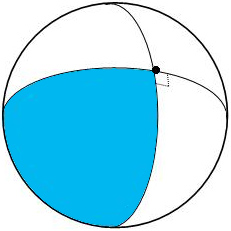

Spheres are unique in the world of 3-dimensional figures. Spheres are perfectly symmetrical. Additionally, they have no edges or vertices. They are not polyhedra like prisms. Spheres are in a world all their own...in fact, our world - Earth - is almost a sphere.
The surface area of a sphere is the number of square units required to completely cover the outer surface of the sphere. The units of area are called square units because they are little squares that are one unit long and one unit wide. Like all measures of area, the name of the unit varies according to the measurement system. The U.S. customary system uses units of area such as square inches or square feet, while the SI/metric system uses units of area such as square meters.
Answer the following questions. Click the blanks to reveal the answers.
Determine an appropriate measure for the area of the everyday items listed below.
A manhole in the street with a diameter a little larger than a yard: ______. square meter.
A round serving dish for meat: ______. square foot.
Surface area, like all measures of area, is also measured in square units. The formula for the surface area of a sphere is: = 4 r2. Why such a strange formula?
r2. Why such a strange formula?
A spherical globe is flattened and pictured below. There are six "lunes" showing different parts of the globe. "Lunes" come from the word "lunar" meaning "like the moon."

Source: Make Your Own Globe, National Maritime Museum
In the diagram below, we can see that a lune, in green, is a section of the surface area of a sphere. We can also see that the lune is formed by two great circles.

Source: Regular digon in spherical geometry, Pbroks13, Wikipedia
If two great circles are perpendicular to each other, then they form four identical or congruent lunes, like in the diagram below.

Pretend to "peel" a sphere. What would we find?



Notice that when we peel a sphere, we get four lunes that can be morphed into circles. The most interesting part of this is that the circles have exactly the same radius as the sphere!
Answer the following questions. Click on the blanks to reveal the answers.
Remember, the formula for the area of a circle is ______. A = πr2. Now we can write a formula for the surface area of a sphere.
The Surface area of sphere with radius r equals ___________ the area of 4 circles with radius r.
The formula for the surface area of a sphere is: S = 4 * πr2 = 4πr2.
Example: A sphere has a diameter of 10 centimeters. Find the surface area of the sphere.
Answer the following questions. Click the blanks to reveal the answers.
Example:
The circumference of a regulation NBA basketball is 29.5 inches. Determine the amount of leather required to cover the basketball to the nearest hundredth of an inch.
Answer the following questions. Click the blanks to reveal the answers.